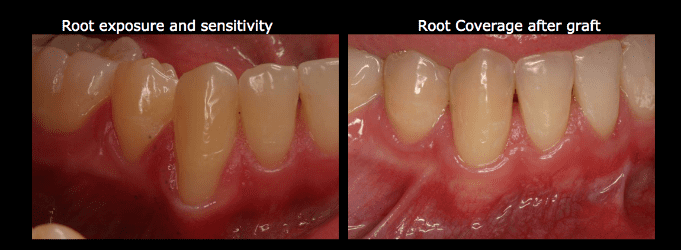Gum Grafting
A gum graft (also known as a gingival graft or periodontal plastic surgery), is a collective name for surgical periodontal procedures that aim to Increase the amount of gum tissue for restorative work, or to cover an exposed tooth root surface when recession of the gums is creating sensitivity, root cavity and unesthetic smile line.
Exposed tooth roots are usually the result of gingival recession due to aggressive brushing habits. There are other common causes, including periodontal disease.
Here are some of the most common types of gum grafting:
- Free gingival graft – This procedure is often used to thicken gum tissue. A layer of tissue is removed from the outer layer of the palate and relocated to the area affected by gum recession. Both sites will quickly heal in a few days. A mouthpiece made prior to grafting will serve as a protective device in the first 24 hours.
- Subepithelial connective tissue graft – This procedure is commonly used to cover exposed roots. Tissue is removed fairly painlessly from the inner layer of the palate and relocated to the site of gum recession.
- Acellular dermal matrix allograft – This procedure uses medically processed, donated human tissue as a tissue source for the graft. The advantage of this is procedure is that there is no need for a donor site from the patient’s palate (and thus, less pain). Unfortunately, since this graft comes from the skin tissue, the color and texture does not match the gum tissue. This option may well serve if the patient is wearing a denture and is not concerned with the looks of the graft.
Reasons for gum grafting
Gum grafting is a common periodontal procedure. Though the name might sound frightening, the procedure is commonly performed with excellent results. It is a rather quick and predictable procedure.
Here are some of the major benefits associated with gum grafting:
- Reduced sensitivity – When the tooth root becomes exposed, eating or drinking hot or cold foods can cause extreme sensitivity to the teeth. Gum grafting surgery permanently covers the exposed root, helps reduce discomfort, and restores the good health of the gums.

- Improved appearance – Periodontal disease is characterized by gum recession and inflammation. Gum recession and root exposure can make the teeth look longer than normal and the smile to appear “toothy.” Gum grafting can make the teeth look shorter, more symmetrical and generally more pleasing to look at. In addition, adjacent tissue can be enhanced and augmented during the procedure for aesthetic purposes.
- Improved gum health – Periodontal disease can progress and destroy gum tissue very rapidly. If left untreated, a large amount of gum tissue can be lost in a short period of time. Gum grafting can help halt tissue and bone loss; preventing further problems and protecting exposed roots from further decay.
What does gum grafting treatment involve?
Once the need for gum grafting surgery has been determined, there are several treatments the periodontist will want perform before gum grafting takes place. First, the teeth must be thoroughly cleaned supra and subgingivally to remove calculus (tartar) and bacteria. The periodontist can also provide literature, advice and educational tools to increase the effectiveness of homecare and help reduce the susceptibility of periodontal disease in the future. (grafting post-op instruction sheet can be found in the patient information section)
The gum grafting procedure is performed under local anesthetic. The exact procedure will depend much on whether tissue is coming from the patient’s palate or a tissue bank.
Initially, small incisions will be made at the recipient site to create a small pocket to accommodate the graft. Then a split thickness incision is made and the connective tissue graft is inserted into the space between the two sections of tissue. The graft is usually slightly larger than the recession area, so some excess will be apparent.
Disolvable sutures are often placed to further stabilize the graft and to prevent any shifting from the designated site. A pre-made mouth piece is used to protect the surgical area during the first day of healing. Uniformity and healing of the gums will be achieved in approximately six weeks.
If you have any questions about gum grafting, please ask Dr. Bashiri and staff.
Our Locations Choose your preferred location
Farrokh Bashiri, DDS Inc
2991 Treat Blvd Suite J, Concord, CA 94518
Farrokh Bashiri, DDS Inc
400 Evelyn Ave Suite 129, Albany, CA 94706
